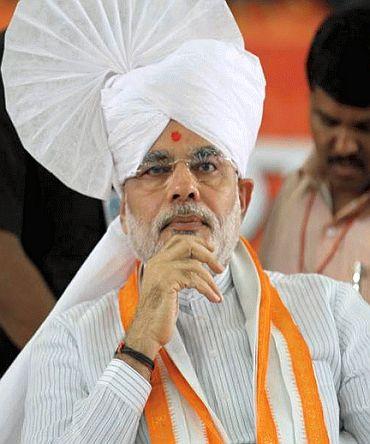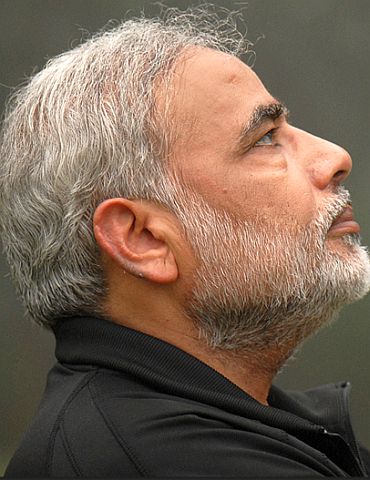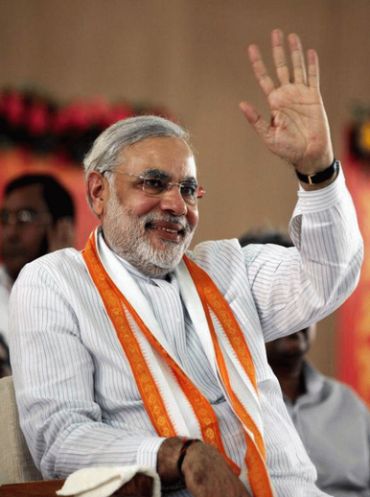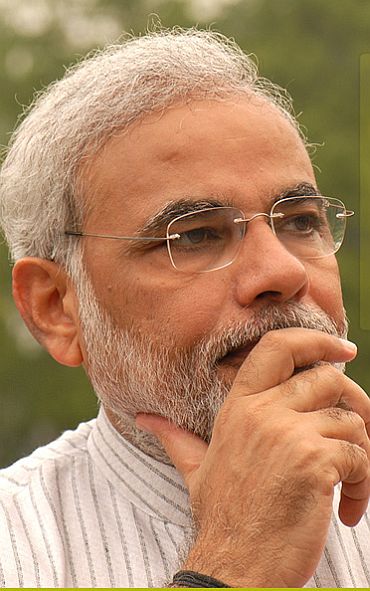
Whether it is health, water or women's empowerment, Modi is wildly popular in his state. But that's only in Gujarat, writes Aditi Phadnis.
Two events have come about in happy conjunction for Gujarat Chief Minister Narendra Modi.
The Supreme Court has asked the widow of Ahsan Jaffrey, who was burnt alive by a mob in the 2002 Gujarat riots, to go back to the trial court with her plea that Narendra Modi was culpable in her husband's murder because he did nothing to stop the rioting and in fact abetted it.
For a Supreme Court that prides itself on being proactive and has something to say on practically every aspect of life, this would appear to be a cop out. Either way, Modi's supporters say this is a huge victory for them. If a criminal case had been registered against the chief minister, he certainly could not have continued in office.
A day after the court order, a report -- that was released in the US on September 1 -- has suddenly caught the attention of the media on September 13. The findings of an in-house US Congressional think tank are that Modi's Gujarat is a model of good governance. Factually, this is incontestable.
....

Investment has poured into Gujarat -- Ford, Tata, Ambani have all moved there and even Maruti Suzuki, one of the companies responsible for Haryana's industrial development, is fed up with labour politics in the state and is thinking of shifting to the state. Whether it is health, water or women's empowerment, Modi is wildly popular in his state.
But the operative words are 'in his state' -- a state that has just 8 per cent Muslims (compared to say 18-22 per cent in UP and elsewhere in India); and a state that has 'inherited' a surplus and knows what to do with it.
This is why leaders like LK Advani keep extolling the Gujarat model of development. One way of looking at their statement is to read it to mean that Modi is essentially a Gujarat leader.
In Gujarat, Modi's development model works very well (although the BJP's seats went down from 127 in the 2002 assembly elections to 117 in the 2007 assembly elections. In the 2009 general elections the BJP got 46.52 per cent of the votes in Gujarat but the Congress got 43.38 per cent. An analysis of the results of the taluka and municipal elections yields similar surprises).
...

There is no leader in the Congress of Modi's stature. His appeal is especially strong among women because he's the first leader in the state to speak of women's empowerment.
He speaks of development, a better life, a better future and Gujarati pride. That's what people want to hear. But that's in Gujarat.
Outside Gujarat, the BJP's core constituency doesn't want to hear any of this. They want to hear how minorities should be straightened out and hear Modi commit himself to a constitutional amendment for mandir wahin banayenge should the BJP come to power in the Centre.
This is especially true of places like Azamgarh and Rampur where the population of Muslims is sizeable, and seen as a threat.
Instead, when the Allahabad High Court delivered its verdict on the Ayodhya case, Modi's reaction was: "I welcome the court's decision and appeal to all to maintain peace. We should all work towards harmony."
Now once again, Modi is on a three-day fast for social harmony. The fact is, BJP voters in Gujarat only want political parties to talk about what they will do for Gujarat. And in the rest of India, no one wants to hear Modi speaking of communal harmony. So there's an image mismatch that Modi will have to resolve.
...

There's another thing. Modi is not the darling of the Rashtriya Swayamsevak Sangh as people would have us believe. The RSS believes that Gujarat is so much a one-person operation that there is no differentiation between the BJP and the Congress.
Modi's differences with the RSS-export into the BJP, Sanjay Joshi, and previous RSS chief V Sudarshan, are well known. So, the RSS is ambivalent about giving unconditional support to him.
And then there is the issue of the BJP's allies. Janata Dal United chief minister Nitish Kumar knows he will shoot himself in the foot and script the resurrection of Lalu Prasad, Ramvilas Paswan and the Congress if he makes any move that is construed by the Muslims -- especially the backward Pasmanda Muslims of Bihar who flocked to vote for JDU -- as an endorsement of Modi.
When Jayalalithaa was elected CM, Modi went to Chennai to attend her swearing in ceremony and congratulated her for her 'grand' victory'. But All India Anna Dravida Munnetra Kazhagam cannot replace the JDU in the National Democratic Alliance, only supplement it.